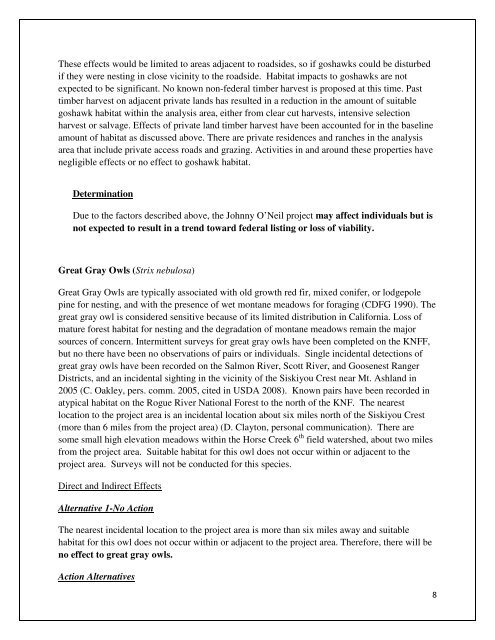Johnny O'Neil Late Successional Reserve Habitat Restoration and ...
Johnny O'Neil Late Successional Reserve Habitat Restoration and ...
Johnny O'Neil Late Successional Reserve Habitat Restoration and ...
Create successful ePaper yourself
Turn your PDF publications into a flip-book with our unique Google optimized e-Paper software.
These effects would be limited to areas adjacent to roadsides, so if goshawks could be disturbed<br />
if they were nesting in close vicinity to the roadside. <strong>Habitat</strong> impacts to goshawks are not<br />
expected to be significant. No known non-federal timber harvest is proposed at this time. Past<br />
timber harvest on adjacent private l<strong>and</strong>s has resulted in a reduction in the amount of suitable<br />
goshawk habitat within the analysis area, either from clear cut harvests, intensive selection<br />
harvest or salvage. Effects of private l<strong>and</strong> timber harvest have been accounted for in the baseline<br />
amount of habitat as discussed above. There are private residences <strong>and</strong> ranches in the analysis<br />
area that include private access roads <strong>and</strong> grazing. Activities in <strong>and</strong> around these properties have<br />
negligible effects or no effect to goshawk habitat.<br />
Determination<br />
Due to the factors described above, the <strong>Johnny</strong> O’Neil project may affect individuals but is<br />
not expected to result in a trend toward federal listing or loss of viability.<br />
Great Gray Owls (Strix nebulosa)<br />
Great Gray Owls are typically associated with old growth red fir, mixed conifer, or lodgepole<br />
pine for nesting, <strong>and</strong> with the presence of wet montane meadows for foraging (CDFG 1990). The<br />
great gray owl is considered sensitive because of its limited distribution in California. Loss of<br />
mature forest habitat for nesting <strong>and</strong> the degradation of montane meadows remain the major<br />
sources of concern. Intermittent surveys for great gray owls have been completed on the KNFF,<br />
but no there have been no observations of pairs or individuals. Single incidental detections of<br />
great gray owls have been recorded on the Salmon River, Scott River, <strong>and</strong> Goosenest Ranger<br />
Districts, <strong>and</strong> an incidental sighting in the vicinity of the Siskiyou Crest near Mt. Ashl<strong>and</strong> in<br />
2005 (C. Oakley, pers. comm. 2005, cited in USDA 2008). Known pairs have been recorded in<br />
atypical habitat on the Rogue River National Forest to the north of the KNF. The nearest<br />
location to the project area is an incidental location about six miles north of the Siskiyou Crest<br />
(more than 6 miles from the project area) (D. Clayton, personal communication). There are<br />
some small high elevation meadows within the Horse Creek 6 th field watershed, about two miles<br />
from the project area. Suitable habitat for this owl does not occur within or adjacent to the<br />
project area. Surveys will not be conducted for this species.<br />
Direct <strong>and</strong> Indirect Effects<br />
Alternative 1-No Action<br />
The nearest incidental location to the project area is more than six miles away <strong>and</strong> suitable<br />
habitat for this owl does not occur within or adjacent to the project area. Therefore, there will be<br />
no effect to great gray owls.<br />
Action Alternatives<br />
8
















